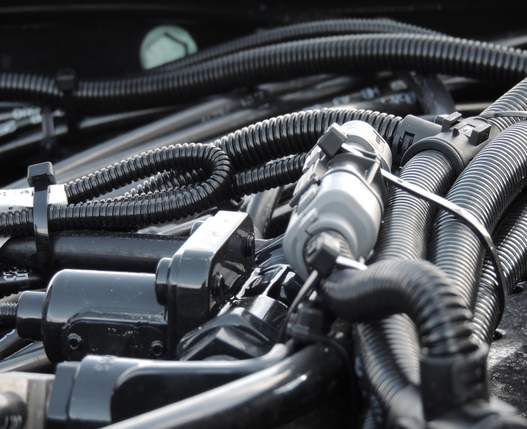Blog

Hydraulic Hose Maintenance Guide: Prolonging Performance
Sep 18, 2023Introduction
The hydraulic system serves as a key component in the complex dance of vehicle machinery, coordinating motions with accuracy and force. The stainless steel hydraulic hose, an essential conduit for conveying hydraulic power, is at the centre of this system. To ensure lifespan and dependability, Imperial Auto, a reputable name in the automobile business, places a high value on preventive maintenance. In this article, we examine Imperial Auto’s careful procedures for protecting the integrity of stainless steel hydraulic hoses, including inspection, cleaning, and replacement methods.
A stainless steel hydraulic hose, which is frequently used in numerous industries, is a crucial part of hydraulic systems. It is a flexible stainless steel conduit that is meant to last and is used to transport hydraulic fluid to operate machinery or equipment. This hose is renowned for its strength, capacity to tolerate high pressure settings, and resistance to corrosion.
Due to the flexibility of its design, it can adapt to various hydraulic system configurations and movements. In demanding applications, stainless steel hydraulic hoses are essential for preserving the reliability and effectiveness of hydraulic systems.
1. The need for Inspection: A Systematic Approach
A. Visual Inspection
The regular inspection of stainless steel hydraulic hoses is the cornerstone of Imperial Auto’s maintenance regimen. The first line of defence is visual inspection, where skilled specialists painstakingly go over the hose’s exterior surface. They search for obvious symptoms of deterioration such as abrasions, cuts, or surface abnormalities. Each of these indications is meticulously categorised for further evaluation.
B. Connecting Fittings
It is crucial that connections between hoses and fittings remain secure. The Imperial Auto technicians examine the seal and look for leaks. To stop potential leaks, any loose fittings are quickly located and tightened again. This procedure guarantees that the hydraulic system will continue to be functional and sealed.
C. Bending Radius and Flexibility
A hydraulic hose’s performance is significantly impacted by its flexibility. Imperial Auto mechanics assess the hose’s flexibility and conformity to the specified bending radius. Any mobility limitations must be immediately corrected because they can cause premature wear. This process aids in preventing structural wear and tear and maintaining ideal performance.
D. Compromise of Integrity
Crimping, or the act of fastening fittings to the hose, is a critical step in the assembly of hydraulic hoses. Imperial Auto uses specialised equipment to check the crimping quality. This step is crucial to guarantee that fittings are firmly secured, guarding against any leaks or hydraulic system failures.
2. Imperial Auto’s Multi-Step Cleaning Process: Cleaning for Longevity
A. Debris Elimination
Hoses go through a careful debris removal process before beginning the cleaning process. The hoses are extensively inspected by technicians, who clean them of any accumulated dirt, debris, or foreign objects. This procedure is essential for avoiding hydraulic fluid contamination, which can impair system performance and even cause damage.
B. Solvent Bath
The hoses are then submerged in a specially designed solvent bath once the debris has been removed. Remaining grease, oil, and other pollutants that may have clung to the surface of the hose over time will be removed by this solution. The hose is rejuvenated, returned to its original state, and given a solvent treatment to ensure peak performance.
C. Drying with high-pressure air
Hoses go through a comprehensive high-pressure air drying process after the solvent bath. This step is crucial for getting rid of any last traces of solvent and moisture from the surface of the hose. It is essential for preventing corrosion and keeping the stainless steel material’s integrity. The hose will remain in top shape and be prepared for reinstallation if it is dried properly.
3. Substitution: Knowing When to Act
A. Excessive Wear
Even with rigorous maintenance, stainless steel hydraulic hoses eventually reach the end of their useful life, as acknowledged by Imperial Auto. Excessive wear is one of the main signs calling for replacement. Replacement becomes necessary if visual checks show considerable abrasion, cuts, or evidence of degradation. The integrity of the hydraulic system is seriously put at risk if a compromised hose is used.
B. Decreased Flexibility
Hoses may lose their initial elasticity as they get older. Their capacity to operate as efficiently as possible inside the hydraulic system may be hampered by this compromise in flexibility. To maintain continuous operation, a hose must be replaced when it can no longer fulfil the required bending radius.
C. Integrity and Leaks Problems
Leaks frequently occurring, especially at fitting connections, is a blatant sign of hose deterioration. Additionally, any crimping integrity degradation requires rapid replacement. When hydraulic fluid is lost due to leaks, system performance is compromised, and if the problem is ignored, greater harm may result.
Conclusion
Imperial Auto’s dedication to the upkeep of stainless steel hydraulic hoses is based on a proactive approach that puts an emphasis on inspection, cleaning, and prompt replacement. By following this all-encompassing plan, Imperial Auto makes sure that their hydraulic systems perform at their very best, reducing downtime and maximising reliability. By taking these steps, Imperial Auto keeps its promise to provide the best automotive solutions. Stainless steel hydraulic hoses are a sturdy pillar in the automobile industry, guaranteeing that vehicles continue to perform at their peak thanks to Imperial Auto’s thorough maintenance procedures.